Using the ESO’s Very Large Telescope Interferometer, scientists have obtained the deepest and sharpest images of Sagittarius A*, the black hole at the center of the Milky Way. They tracked the orbits of stars and were able to more precisely measure the mass of the black hole. Plus, new ways to research meteors, and a review of a Peak Design camera anchor system.
Podcast
Show Notes
Jets of young stars may feed planet formation
- NAOJ press release
- “‘Ashfall’ Induced by Molecular Outflow in Protostar Evolution,” Yusuke Tsukamoto, Masahiro N. Machida, and Shu-ichiro Inutsuka, 2021 October 15, The Astrophysical Journal Letters
Modelers image Mars around other Stars
- LASP press release
A last gasp of star formation may come from active galaxies
- RAS press release
- “Rejuvenation triggers nuclear activity in nearby galaxies,” Ignacio Martín-Navarro, Francesco Shankar, and Mar Mezcua, 2021 October 20, Monthly Notices of the Royal Astronomical Society Letters
Stars reveal the mass of Sag A*
- ESO press release
- “Mass distribution in the Galactic Center based on interferometric astrometry of multiple stellar orbits,” R. Abuter et al., to be published in Astronomy & Astrophysics
Lightning spotting sats used to study fireballs
- Data from Satellites Help Uncover Exploding Meteors (Eos)
- “An automated bolide detection pipeline for GOES GLM,” Jeffrey C.Smith et al., 2021 November 1, Icarus
NASA studies meteor smoke trails
- NASA press release
Transcript
Hello and welcome to the Daily Space. I am your host, Beth Johnson.
And I am your host Erik Madaus.
And we are here to put science in your brain.

How we understand our universe is a constant back and forth between theorists and observationalists. On one side, brilliant teams of theorists combine math and software to model how things in our universe should change with time, based on all the physics they can recognize needs to be included. Then, equally brilliant teams of observers use engineering and software to measure what is actually going on as well as they can, and more often than not, they discover things are similar but not identical to those models, and more physics is needed in those models.
In recent years, observers using the Atacama Large Millimeter/submillimeter Array (ALMA) telescope have been able to observe massive dust disks around young stars and the formation of planets in those disks. Looked at quickly, all is as it should be, but if you look closely, it becomes apparent those disks are way larger than anyone expected. It just hadn’t been believed that young solar systems would have dust at large distances.
So, it’s time to fix the models.
A team at the National Astronomical Observatory of Japan and including members at Kagoshima University used the ATERUI II supercomputer to make the first-ever models to look at dust motion in a growing disk around a star with gas outflows. This allowed them to follow the dust as it got caught up in the stellar jets and then rained down in the outskirts of the model solar system. This work was led by Yusake Tsukamoto, who commented: Living in Kagoshima, in the shadow of the active volcano Mt. Sakurajima, I naturally thought of volcanic ashfall when I saw the simulation results.
And just as ash can create a fertile landscape, this ash seems to make solar systems ready to birth far-out worlds.
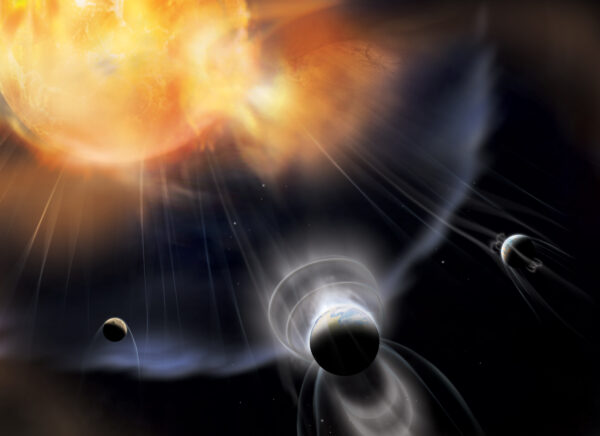
We’ve said it before, and we’ll say it again: we don’t fully understand how solar systems form. Planetary scientists want to solve this problem, and different teams are looking at all the different aspects of solar system formation and evolution.
In fact, one team is even imagining what the fate of a world like Mars would be if it were placed in orbits around other kinds of stars. Presenting their work at this week’s American Geophysical Union conference in New Orleans, a multidisciplinary team looks at how our planet Mars would keep or lose its atmosphere in situations such as orbiting a small but occasionally violent red dwarf star. According to team member David Brain: Mars is a remarkable natural experiment that demonstrates how its atmosphere and, therefore, its habitability can be affected by the properties of both the planet and the star it orbits.
Oh, and that imaginary Mars around a red dwarf? It would lose its atmosphere faster than our real Mars has. And so far, a solar system with a long-term habitable Mars just hasn’t been described. We hope they’re saving that result for a future paper.
Planetary science isn’t the only area of astronomy where we’re constantly working to add details. Galaxies — they also have ways of showing us new ways of behaving as they slowly evolve and die over the history of the universe.
And this death – by which we mean an end of star formation – is not a steady process.
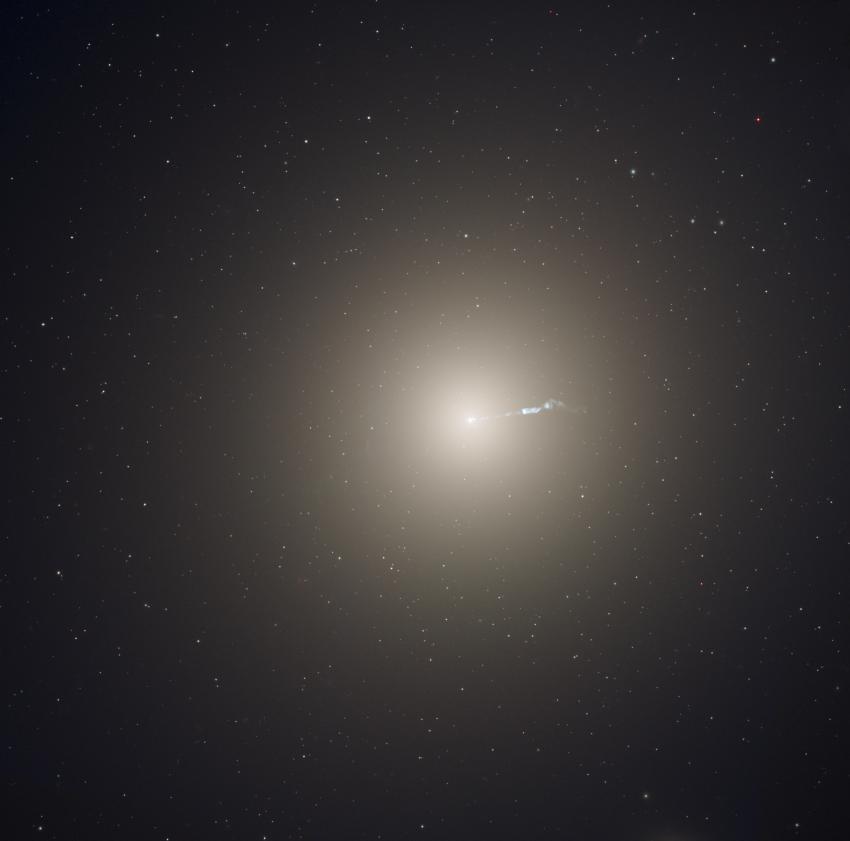
New work published in the Monthly Notices of the Royal Astronomical Society and led by Ignacio Martín-Navarro, looked at 3,000 nearby galaxies with actively feeding black holes. These systems have bright cores that are illuminated by a hot disk of material infalling toward the black hole. And now we know, these systems often have bursts of star formation.
It had been thought that in the modern universe, these massive systems would be slowing down their star formation, but it now appears that an active black hole may coincide with a rejuvenation phase in star formation. According to a Royal Astronomical Society press release on this research: The team concluded that current AGN activity may be contributing to, but not causing, the observed quenching of star birth. The rejuvenation of galaxies with active nuclei may thus be the “last breaths” in the lives of galaxies before they completely stop forming new stars.
There is something sad but poetic about these systems having a last burst of star birth before they die. But that is more of a story for philosophers than scientists.
One of the most amazing breakthroughs of modern astronomy has been the ability to image stars and gas blobs orbiting the center of our galaxy. The early work was done by Andrea Ghez at UCLA using the Keck telescope to peer into the heart of the galaxy and see what infrared light could be seen making its way out through the dust of the inner galaxy.
Seeing what’s going on in the center of our galaxy is a doubly difficult problem. Not only are astronomers trying to make out the details of objects located 27,000 light-years away, but they are also trying to make those details out through the fog of intervening matter. If you’ve ever gone out on a summer’s night and looked at the glowing swath of the Milky Way with binoculars, you may have noticed it is rich in not just stars but also bright and dark nebulae that block light from behind them.
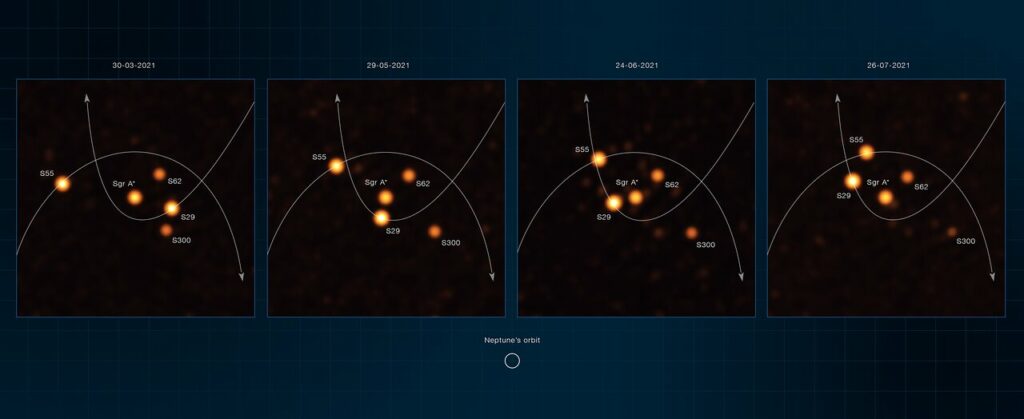
Exactly what colors are blocked depends on how much of what size dust and gas is out there. In general, dust will first scatter blue light, making things look more and more red, just like sunlight looks redder and redder the closer the Sun gets to the horizon. When a cloud of material gets thick enough, it will block all visible light, and the only way to see what is behind the dust is to look in infrared light. So Andrea Ghez developed techniques to look toward the center of the galaxy in the infrared and to do so in such a way that the blurring caused by our own atmosphere could be taken out of the images.
Working in the 1990s, she started by taking high-speed images and then aligning them using brighter objects, and with the build-up of image after image, she was able to tease out the light of stars orbiting our galaxy’s central supermassive black hole, which is named Sagittarius A*. Over the decades, she and others have pushed the world’s largest telescopes to the limits of their abilities and worked to understand both the mass of Sag A* and the small volume it occupies. This work demonstrated that our galaxy doesn’t have a swarm of dense objects or any other “not a black hole” possibilities for what’s in its core, and it earned Ghez, along with competing observer Reinhard Genzel, the Nobel Prize.
While this is all amazing, astronomers are never satisfied with their results, and there is always someone looking for some way to see more and understand more. And while Ghez may have used the biggest telescopes in the world to look at Sag A*, she hadn’t combined them to work together as a single combined telescope.
Using the Very Large Telescope in Chile, which is actually a system of four 8.2-meter telescopes and four 1.8-meter ancillary telescopes, researchers, including Genzel, were able to make out details closer to the center of the galaxy than ever before, and along the way, they caught the motions of stars. The observations were taken between March and July 2021, and during this time, in May, the star S29 made its closest approach to Sag A*, getting just 90 astronomical units (AU) from the black hole. For comparison, Voyager 1 is 155 AU from the Sun, and New Horizons is more than 50 AU out. S29 would be within our solar system if Sag A* were placed where our Sun is. This team is seeing a solar system sized volume 27,000 light-years away! And these observed motions put the mass of Sag A* at 4.3 million solar masses.
Honestly, I don’t care that much just how much mass that black hole has. Folks, we are watching stars fly around in the center of our galaxy, and we’re watching some intervening stars sit unmoving in our field of view. Those moving stars – that is motion seen over months not years, and this is amazing.
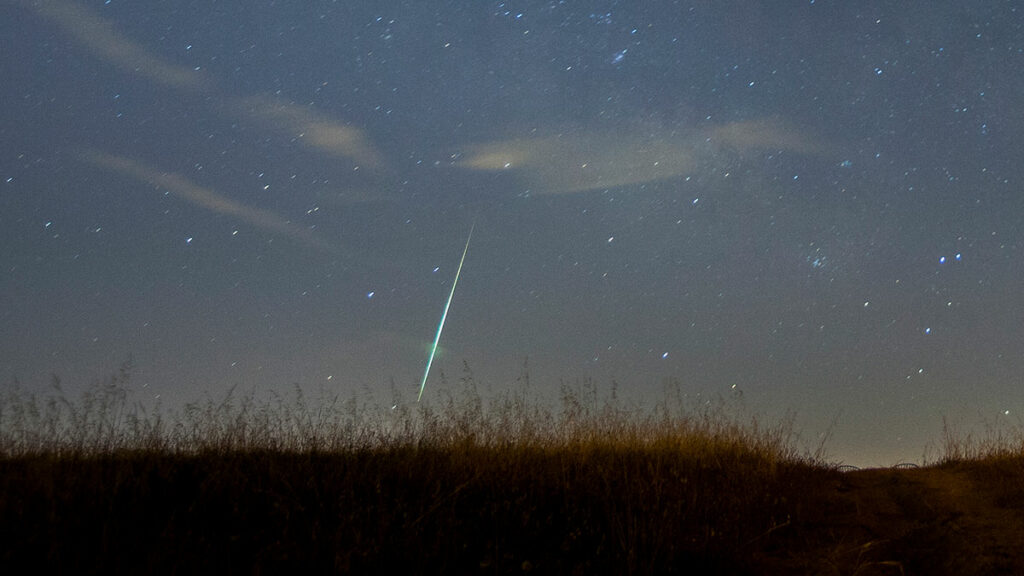
Whether looking for stars around the black hole at the center of our galaxy or looking for fireballs in the night sky, scientists appreciate the struggle of observing the small, the distant, and the rare. And when it comes to those fireballs, we have mostly relied on a few all-sky video camera systems, scattered dashcams, and eye-witness accounts. So astronomers are always trying to find a way to collect more data and, of course, do so at a low cost.
Now, a team of scientists led by Jeffrey Smith from the SETI Institute has not only repurposed data from two weather satellites, but they have also programmed a machine-learning algorithm to analyze the data. First off, the data they are using was lightning mapping data collected by the GOES 16 and 17 satellites. Second, the machine learning analysis increased the detection rate of fireballs from 0.2% to 80%.
And that’s amazing news for planetary defense researchers.
Here’s how it works. The Geostationary Lightning Mapper instruments aboard the two satellites detect a bright flash. The team downloads the data from a public database and sets the algorithm on it. That algorithm then goes through and determines based on the type of flash which ones were bolides or fireballs. Now since the rate is only at 80%, human eyes have to confirm the findings carefully, but the team hopes to increase the detection rate to 95% in the near future.
How big are the rocks exploding in our atmosphere? Between 0.1 and 3 meters in diameter. And they occur often enough to produce statistically significant data patterns. Plus, the way the meteors break up in our atmosphere and then flame out can help us understand the internal strength of the object, which will then help scientists plan on how to deal with these impacts going forward.
Meteors aren’t just pretty lights in the sky. They are a reminder that our planet is getting hit with space rocks every day.

Speaking of space rocks, has anyone gone out and looked at the Geminid meteor shower, yet? It has been gray and rainy here in the San Francisco Bay Area, so I have been completely out of luck and quite damp, to be honest.
We talked on last week’s What’s Up and on several previous episodes about just what makes a meteor shower. Generally, comets passing through our solar system routinely leave dust trails as they heat up on approach to their closest points to the Sun, and some of those dust trails cross Earth’s orbit. Then the Earth passes through those dust trails, and the little bits of dust and rock burn up in our atmosphere, creating meteor showers, some with great regularity like the Geminids.
Except the Geminids are caused by dust from an asteroid and not a comet, but hey. There always has to be an exception to the rule, right?
The meteors not only flare with light, but they leave behind smoke trails. And there are a lot of bits of dust that burn up and we don’t see the bright flash of light. Again, space rocks all day, every day. NASA has been using a neat instrument called the Solar Occultation for Ice Experiment, or SOFIE, aboard a satellite since 2007 to collect data on all the smoke generated by these tiny rocks. Over a decade, scientists analyzed that data to figure out just what all the dust was composed of and how much hits Earth every day.
They found that much of that cosmic dust is iron-rich olivine, and about 25 tons of it make it to Earth every day. Additionally, the smoke from these impacts may be a big reason for those pretty noctilucent clouds people take pictures of. The smoke provides tiny, tiny grains of dust that ice crystallizes on, and then voila, thin, wispy, and very reflective clouds are created.
Also, that iron-rich dust could be helping photosynthesis in the ocean.
So maybe rocks hitting our atmosphere and burning up aren’t a bad thing all around. It’s just those bigger rocks that don’t burn up that we need to worry about.
Review
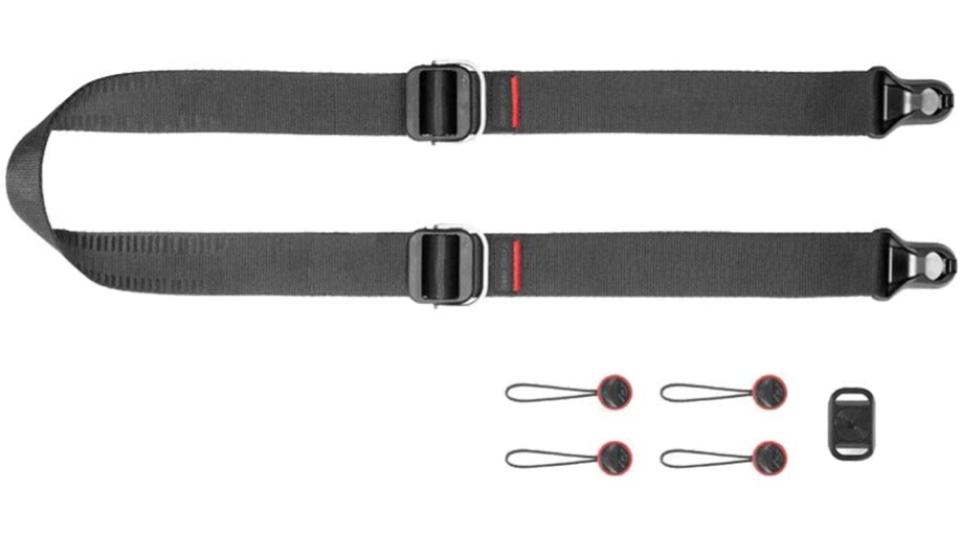
The thing I’m gonna review this week is Peak Design’s strap system. One of the most frustrating things about setting my camera up the first time was attaching the conventional strap to the eyelets on the camera body, and if I wanted to remove the strap to use it on a tripod for astrophotography, I would have to reverse the process and go through the struggle of attaching it again to use it during the day. There were also pieces that could be lost.
This wasn’t fun.
Then I learned about the Peak Design Anchor system. The system works by using magnetic quick disconnects that Peak Design calls Anchors. They are made out of Kevlar rated for 90 kilograms of weight each, according to the manufacturer. They are multilayered so you can see if one is damaged and replace it before it completely breaks. The Anchors attach to the eyelets on your camera with a knot called a cow hitch which is very strong. Even with my fine motor skill problems, it was easy to securely install the Anchors to my camera, and once that was done, changing or removing straps takes a matter of seconds even in the field. The Anchors themselves slide into Links where they click into place, though this is slightly tricky and takes some practice.
For most things, you only need the two Anchors on the camera body, but for my setup, I have five: two on the top, one on a quick release plate, and two on my 600-millimeter lens, using an Anchor Mount which screws into the tripod mount on the lens. With the 100-400 millimeter, I put one end of the strap on the top and the other on the bottom so it balances comfortably, hanging horizontally not vertically.
Peak Design offers a whole array of products that Anchors can attach to, from wrist straps to phone cases. I’ve personally used the Slide Lite and Leash straps and also the Cuff wrist strap.
The Leash strap is good for a small body with a prime lens. The small size helps with taking things out of a bag easily, which is a problem when I have my 24-240 millimeter lens and small camera bag. The Leash comes in four different colors so that you can accessorize it with the rest of your setup and outfit if you want. I have the silver one because it was what was in stock at the time I wanted to get one. Pandemic supply chain anyone?
The Slide Lite is good for heavier lenses, such as the Canon RF 600mm and RF 100-400mm lenses I’ve reviewed recently. It’s comfortable to walk without holding on to the camera at all times because the strap keeps it from bouncing. It has a grippy surface on the inside near where it goes over your shoulder and back to make it even more comfortable. Build quality is pretty good, and it’s easy to adjust the length of the strap. It comes in the same four colors as the Leash, with the strap made of the main color and an accent color next to the length adjustment. You can get one and support the show by using the Amazon affiliate link in the show notes for today’s episode:
There is a larger strap called the Slide for even larger and heavier bodies and lenses, but I haven’t used it.
I liked the idea of the Cuff wrist strap so I could fit a complete camera in a jacket pocket and leave a bag at home. I got one a few weeks ago. It works well for that situation and lets me have my hands free when needed. Peak Design sells a more complicated wrist strap called the Clutch for heavier setups; however, this requires removing an Anchor from one of the eyelets, so I went with the Cuff which attaches to an Anchor only.
There are also quick-release plates that Anchors can be fitted to. I have the Dual Plate to fit on my tripod; the Standard Plate is Arca Swiss compatible.
Peak Design also offers bags and backpacks to fit gear in. I have an Everyday 10-liter bag, and it fits my EOS RP with a 600-mm lens attached and also my 100-400mm lens. It has a divider in the main area of the bag which I don’t use, but it’s well built. The bag also has an outside pocket where I put spare straps and a granola bar or something. There’s an internal pocket, too, where I put spare batteries and memory cards. This is really useful for when I forget to turn off my camera, and it drains the battery which has happened a non-zero number of times. One day, I’ll learn.
This has been the Daily Space.
You can find more information on all our stories, including images, at DailySpace.org. As always, we’re here thanks to the donations of people like you. If you like our content, please consider joining our Patreon at Patreon.com/CosmoQuestX.
Credits
Written by Pamela Gay, Beth Johnson, and Erik Madaus
Hosted by Beth Johnson and Erik Madaus
Audio and Video Editing by Ally Pelphrey
Content Editing by Beth Johnson
Intro and Outro music by Kevin MacLeod, https://incompetech.com/music/


 We record most shows live, on Twitch. Follow us today to get alerts when we go live.
We record most shows live, on Twitch. Follow us today to get alerts when we go live.